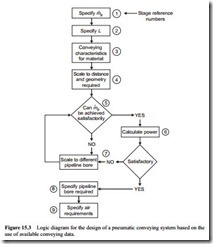The use of test data in system design
The application and use of test data is probably the most common method of designing a pneumatic conveying system. This is used extensively in cases where test data or pre- vious experience with a material is available. Where no previous experience with a particular material is available, it is usual to obtain test data specifically for the purpose of system design, since the use of mathematical models is particularly unreliable in these situations. As for the section on the use of equations in system design, two logic dia- grams are also presented here, one for the original design of a system, and another for evaluating the capability of an existing system.
Related posts:
Applied Pneumatics:Automation and robotics
Applications on pneumatic:Air springs
Air flow rate evaluation:Stepped pipeline systems
Erosive wear:Wear of straight pipeline
Review of pneumatic conveying systems:Mobile systems
Pressure and flow:Pascal's law.
Conveying capability:High pressure conveying – Part IV
COMPRESSORS:Axial Compressors
HYDRAULIC FLUIDS:PURPOSE OF THE HYDRAULIC FLUID
Hydraulic fluids:Foam-resistant fluids
Control components in a hydraulic system:Sequencing valve.
Hydraulic Pumps and Pressure Regulation:Pressure regulation
SUMMARY OF ENERGY TRANSFER BY HEAT,WORK,AND MASS
RANKINE CYCLE: THE IDEAL CYCLE FOR VAPOR POWER CYCLES
INTRODUCTION TO FLUID MECHANICS:VISCOSITY
